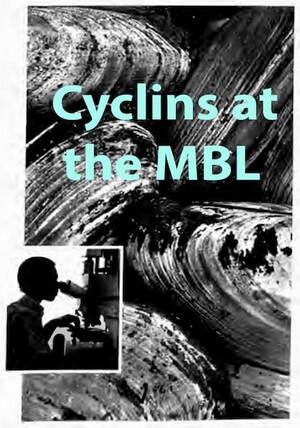Eukaryotes have multiple cyclins, each of which activates a different cyclin dependent kinase responsible for regulating a different part of the cell cycle. During the cell cycle, the cell produces different cyclins at different time points, while the level of cyclin dependent kinases remain the same throughout the cycle, and are only activated in the presence of a cyclin.
The necessity of changing levels of cyclin requires that cyclins are both manufactured and degraded by the cell during the cell cycle. The degradation of cyclins is carried out through a ubiquitin pathway. Ubiquitin is a small protein found in almost all tissues in eukaryotes. At certain points during the cell cycle, ubiquitin is signaled to bond with a cyclin, and with the addition of several enzymes, the cyclin degrades (Hershko, 1999: 1571). With that degradation of cyclin, the cyclin dependent kinase responsible for that phase of the cell cycle deactivates and the next cyclin dependent kinase is activated by the production of a different cyclin. The process continues until the end of the cell cycle, when all cyclins have been sequentially degraded.
What are Cyclins?
- Branden, C. I. (1999). Introduction to Protein Structure. New York: Garland Science. - https://books.google.com/books?id=eUYWBAAAQBAJ&pg=PA107&lpg=PA107&dq=domain+structure+of+cyclins&source=bl&ots=Pz5XNBd3kZ&sig=n2O3Cw0Vr8GmvuV0y-KF6i0PfYw&hl=en&sa=X&ei=BQl3VfOqMu-HsQTY5YOwDQ&ved=0CGIQ6AEwCw#v=onepage&q=domain%20structure%20of%20cyclins&f=false
- Hershko, A. (1999). Mechanisms and regulation of the degradation of cyclin B. Philosophical Transactions of the Royal Society B: Biological Sciences, 354(1389), 1571-1576.
- Nobel Prize, 2001. http://www.nobelprize.org/nobel_prizes/medicine/laureates/2001/hunt-bio.html
Early Work with Cyclins
- Boveri, T. (1902). On multipolar mitosis as a means of analysis of the cell nucleus. Foundations of experimental embryology, 1964, 74-97.
- Franz, S. (2002). http://www.nature.com/celldivision/milestones/full/milestone02.html
- Greaves, S. (2002). http://www.nature.com/celldivision/milestones/full/milestone07.html
- Jackson, P.K. (2008). The Hunt for Cyclin. Cell, 134, 199-202
- MBL History Project. "Joan Ruderman Cyclin Research I." Filmed June 2015. MBL History Project Video, 5:58. Posted June 2015. http://history.archives.mbl.edu/node/16066.
- MBL History Project. "Joan Ruderman Cyclin Research II." Filmed June 2015. MBL History Project Video, 8:55. Posted June 2015. http://history.archives.mbl.edu/content/joan-ruderman-cyclin-research-ii-june-5-2015.
- Mitchell, A. (2002). http://www.nature.com/celldivision/milestones/full/milestone03.html
- Nath, D. (2002). http://www.nature.com/celldivision/milestones/full/milestone06.html
- Patterson, M. (2002). http://www.nature.com/celldivision/milestones/full/milestone05.html
- Rosenthal, E. T., Hunt, T., & Ruderman, J. V. (1980). Selective translation of mRNA controls the pattern of protein synthesis during early development of the surf clam, Spisula solidissima. Cell, 20(2), 487-494.
- Surridge, C. (2002). http://www.nature.com/celldivision/milestones/full/milestone01.html
Tim Hunt and His Discovery of Cyclin
- Evans, T., Rosenthal, E. T., Youngblom, J., Distel, D., & Hunt, T. (1983). Cyclin: a protein specified by maternal mRNA in sea urchin eggs that is destroyed at each cleavage division. Cell, 33(2), 389-396.
- Gerhart, J., Wu, M., & Kirschner, M. (1984). Cell cycle dynamics of an M-phase-specific cytoplasmic factor in Xenopus laevis oocytes and eggs. The Journal of Cell Biology, 98(4), 1247-1255.
- Hunt, T. (2001, December 9). Tim Hunt Nobel Lecture Protein Synthesis, Proteolysis, and Cell Cycle Transitions." Nobelprize.org. Retrieved from: http://www.nobelprize.org/nobel_prizes/medicine/laureates/2001/hunt-lecture.html
- Hunt, T. (2004). The Discovery of Cyclin (I). Cell, S116, S63-S64.
- Jackson, P.K. (2008). The Hunt for Cyclin. Cell, 134, 199-202
- Masui, Yoshio, and Clement L. Markert. "Cytoplasmic control of nuclear behavior during meiotic maturation of frog oocytes." Journal of Experimental Zoology Part A: Ecological Genetics and Physiology 177, no. 2 (1971): 129-145.
- Pulverer, B. (2002). http://www.nature.com/celldivision/milestones/full/milestone12.html
- Swenson, K. I., Farrell, K. M., & Ruderman, J. V. (1986). The clam embryo protein cyclin A induces entry into M phase and the resumption of meiosis in Xenopus oocytes. Cell, 47(6), 861-870.
Cyclins and Genetics
- Ciechanover, A., Finley, D., & Varshavsky, A. (1984). Ubiquitin dependence of selective protein degradation demonstrated in the mammalian cell cycle mutant ts85. Cell, 37(1), 57-66.
- Glotzer, M., Murray, A. W., & Kirschner, M. W. (1991). Cyclin is degraded by the ubiquitin pathway. Nature, 349(6305), 132-138.
- Goldstein, G., Scheid, M., Hammerling, U., Schlesinger, D. H., Niall, H. D., & Boyse, E. A. (1975). Isolation of a polypeptide that has lymphocyte-differentiating properties and is probably represented universally in living cells. Proceedings of the National Academy of Sciences, 72(1), 11-15.
- Gould, K. L. & Nurse, P. (1991). Tyrosine phosphorylation of the fission yeast cdc2+ protein kinase regulates entry into mitosis. Nature 342, 39-45.
- Greenwood, E. (2002). http://www.nature.com/celldivision/milestones/full/milestone09.html
- Hartwell, L. H., Culotti, J., Pringle, J. R., & Reid, B. J. (1974). Genetic control of the cell division cycle in yeast. Science, 183(4120), 46-51.
- Hershko, A. (1991). The ubiquitin pathway for protein degradation. Trends in biochemical sciences, 16, 265-268.
- Hershko, A. (1999). Mechanisms and regulation of the degradation of cyclin B. Philosophical Transactions of the Royal Society B: Biological Sciences, 354(1389), 1571-1576.
- Nature. (2004). A prize for protein degradation. Nature Cell Biology, 6(1011), doi:10.1038/ncb1104-1011.
- Nobel Prize 2001 http://www.nobelprize.org/nobel_prizes/medicine/laureates/2001/
- Nobel Prize 2004 http://www.nobelprize.org/nobel_prizes/chemistry/laureates/2004/ ; http://www.nobelprize.org/nobel_prizes/chemistry/laureates/2004/hershko-bio.html
- Nurse, P. (1975). Genetic control of cell size at cell division in yeast. Nature, 256, 547-551.
- Nurse, P., & Thuriaux, P. (1980). Regulatory genes controlling mitosis in the fission yeast Schizosaccharomyces pombe. Genetics, 96(3), 627-637.
- Patterson, M. (2002). http://www.nature.com/celldivision/milestones/full/milestone05.html
- Russell, P. & Nurse, P. (1986). cdc25+ functions as an inducer in the mitotic control of fission yeast. Cell 45, 145-153.
- Schoenheimer, R. (1942). The Dynamic State of Body Constitutents. Cambridge: Harvard University Press.
- Varshavsky, A. (2006). The early history of the ubiquitin field. Protein science, 15(3), 647-654.

